Common Sense Teaching
 Suppose a husband and wife came to you for lessons. You ask them what they want out of the lessons, and the husband says, “I want to stop slicing.” The wife says, “I just want to get the ball into the air.”
Suppose a husband and wife came to you for lessons. You ask them what they want out of the lessons, and the husband says, “I want to stop slicing.” The wife says, “I just want to get the ball into the air.”
You see that they have a myriad of problems which would require many lessons to straighten out. But, you also see that you can give them some quick instruction that would help reach their immediate goals, even though it would leave them with a number of swing flaws.
What would you do? By the way, this isn’t a theoretical situation – this scenario actually played out for one of our USGTF instructors at an America’s Favorite Golf Schools location.
Let’s stop and think about this for a bit. It’s natural to want to help students attain the best fundamentals possible. Often, this means making some difficult changes, and usually their games will get worse before getting better. If a student is willing to commit to a series of lessons, most teachers will probably go the route of making the difficult changes.
But, realistically, what percent of students actually commit to a series of lessons over a long time frame? There are some teachers who only teach this way, but more common is the golfer who drops in for a lesson or two to straighten out what is currently going wrong. Even in a five-day golf school, getting a student to make wholesale changes successfully is unlikely.
So now we have a classic teacher’s dilemma: providing a quick fix that immediately helps, or sacrificing immediate results by giving more of a long-term program that eventually should result in greater improvement.
First, let’s make it clear that not all quick fixes are “band-aid” solutions. A band-aid solution is one that is not grounded in true fundamentals. For example, suppose our student is pulling the ball straight left with a square stance. We figure he could hit the ball straighter by simply closing his stance. Sure, it works for the time being and may even last for awhile, but is that really a good solution? Compensating for flaws by introducing another one is almost always counterproductive in the long run.
It’s important to realize that we must give the student what he or she wants. In the case of the woman who just wanted to get the ball up into the air, she was hitting ground balls because her weight was on her left foot at address and her body was ahead of the ball. As a result, her hands were so far ahead of the ball that the club was completely de-lofted at impact.
Our USGTF instructor set her up in a more correct position at address. Immediately, she started getting the ball into the air, and she was ecstatic. There was only one problem, though. Through impact and follow-through she was leaning slightly backwards instead of moving forward, which resulted in the ball going a little too high, ironically, and fairly short.
Because the instruction that allowed the woman to get the ball airborne was grounded in sound fundamentals, this cannot be classified as a band-aid solution. Even so, it’s certainly tempting to help the woman get a better and more penetrating ball flight by now focusing on her movement through impact.
Again, let’s stop and think about this for a bit. We still see that she has numerous flaws. The teacher in us wants to help fix those things, which is only natural. On the other hand, all this woman knows is that she’s now getting the ball up, which is all she ever wanted to do. Why ruin a good thing by going on?
Her husband just wanted his slice fixed. He had the typical slicer’s swing, where he came over the top with a wide-open clubface. Our USGTF instructor gave the man a simple lesson on ball flight laws, and explained how he needed to swing the club down the target line through impact instead of to the left. The teacher had the man hit shots with half-swings so he could get the feel of the clubpath and clubface angle being correct. When the student proceeded to a full swing, he started hitting the ball straight.
At this point, the teacher could have fixed the man’s grip, which was poor. He could have worked on his transition move, which was costing him power. He could have tried correcting a number of other things the man was still doing wrong. But, just like his wife, the man got what he wanted.
We might think these students’ goals were too modest, and with just a little bit of extra teaching and effort they can do better. But remember: it’s not our job to tell our students what their goals should be. If the wife is thrilled merely getting the ball up in the air, and the husband is happy his slice is gone, then that should be good enough for us.
Our ambitions for our students’ games may be greater than theirs. While perhaps difficult, the best course of action is to simply accept this fact and be glad for them.




